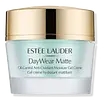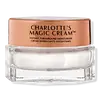What's inside
What's inside
 Key Ingredients
Key Ingredients

 Benefits
Benefits

 Concerns
Concerns

 Ingredients Side-by-side
Ingredients Side-by-side

Water
Skin ConditioningIsododecane
EmollientButylene Glycol
HumectantPolypropylene
Dimethicone
EmollientBis-PEG-18 Methyl Ether Dimethyl Silane
EmollientGlycerin
HumectantSilica
AbrasiveTetrahexyldecyl Ascorbate
AntioxidantTocopheryl Acetate
AntioxidantThermus Thermophillus Ferment
Skin ConditioningErgothioneine
AntioxidantEthylbisiminomethylguaiacol Manganese Chloride
AntioxidantAmmonium Acryloyldimethyltaurate/Vp Copolymer
Pyrus Malus Fruit Extract
Skin ConditioningLens Esculenta Fruit Extract
Skin ConditioningCitrullus Lanatus Fruit Extract
Skin ConditioningLaminaria Saccharina Extract
Skin ProtectingNarcissus Tazetta Bulb Extract
AstringentCucumis Sativus Fruit Extract
EmollientTrehalose
HumectantAlgae Extract
EmollientLactobacillus Ferment
Skin ConditioningCaffeine
Skin ConditioningAcetyl Glucosamine
Skin ConditioningHordeum Vulgare Extract
EmollientPolysilicone-11
Acrylates/C10-30 Alkyl Acrylate Crosspolymer
Emulsion StabilisingPropylene Glycol Dicaprate
EmollientHelianthus Annuus Seedcake
AbrasiveSodium Lactate
BufferingSodium Hyaluronate
HumectantLecithin
EmollientLaureth-23
CleansingTromethamine
BufferingCitric Acid
BufferingCyclodextrin
AbsorbentCaprylyl Glycol
EmollientLaureth-4
EmulsifyingOleth-10
EmulsifyingSodium PCA
HumectantParfum
MaskingHexylene Glycol
EmulsifyingDisodium EDTA
BHT
AntioxidantSodium Benzoate
MaskingPotassium Sorbate
PreservativePhenoxyethanol
PreservativeLinalool
PerfumingBenzyl Salicylate
PerfumingCI 42090
Cosmetic ColorantWater, Isododecane, Butylene Glycol, Polypropylene, Dimethicone, Bis-PEG-18 Methyl Ether Dimethyl Silane, Glycerin, Silica, Tetrahexyldecyl Ascorbate, Tocopheryl Acetate, Thermus Thermophillus Ferment, Ergothioneine, Ethylbisiminomethylguaiacol Manganese Chloride, Ammonium Acryloyldimethyltaurate/Vp Copolymer, Pyrus Malus Fruit Extract, Lens Esculenta Fruit Extract, Citrullus Lanatus Fruit Extract, Laminaria Saccharina Extract, Narcissus Tazetta Bulb Extract, Cucumis Sativus Fruit Extract, Trehalose, Algae Extract, Lactobacillus Ferment, Caffeine, Acetyl Glucosamine, Hordeum Vulgare Extract, Polysilicone-11, Acrylates/C10-30 Alkyl Acrylate Crosspolymer, Propylene Glycol Dicaprate, Helianthus Annuus Seedcake, Sodium Lactate, Sodium Hyaluronate, Lecithin, Laureth-23, Tromethamine, Citric Acid, Cyclodextrin, Caprylyl Glycol, Laureth-4, Oleth-10, Sodium PCA, Parfum, Hexylene Glycol, Disodium EDTA, BHT, Sodium Benzoate, Potassium Sorbate, Phenoxyethanol, Linalool, Benzyl Salicylate, CI 42090
Water
Skin ConditioningC12-15 Alkyl Benzoate
AntimicrobialGlyceryl Stearate Se
EmulsifyingButylene Glycol
HumectantGlycerin
HumectantIsononyl Isononanoate
EmollientCaprylic/Capric Triglyceride
MaskingCetyl Alcohol
EmollientEthylhexyl Palmitate
EmollientCyclopentasiloxane
EmollientDimethicone
EmollientPolyester-7
Skin ConditioningPhenoxyethanol
PreservativeNeopentyl Glycol Diheptanoate
EmollientHydrogenated Rapeseed Oil
EmollientButyrospermum Parkii Butter
Skin ConditioningSteareth-21
CleansingAvena Sativa Kernel Extract
AbrasiveCarbomer
Emulsion StabilisingDimethiconol
EmollientPotassium Cetyl Phosphate
EmulsifyingChlorphenesin
AntimicrobialCaprylyl Glycol
EmollientXanthan Gum
EmulsifyingHydrolyzed Viola Tricolor Extract
Skin ProtectingAllantoin
Skin ConditioningAloe Barbadensis Leaf Juice Powder
Skin ConditioningDisodium EDTA
Tocopheryl Acetate
AntioxidantCamellia Oleifera Seed Oil
Skin ConditioningRosa Canina Fruit Oil
EmollientRosa Damascena Extract
MaskingSodium Hydroxide
BufferingHelianthus Annuus Seed Oil
EmollientMichelia Alba Leaf Oil
MaskingSodium Lactate
BufferingPEG-8
HumectantEthylhexylglycerin
Skin ConditioningCoco-Glucoside
CleansingSodium Hyaluronate
HumectantTocopherol
AntioxidantAscorbyl Palmitate
AntioxidantPlumeria Rubra Flower Extract
Skin ConditioningAscorbic Acid
AntioxidantCitric Acid
BufferingPalmitoyl Tripeptide-1
Skin ConditioningPalmitoyl Tetrapeptide-7
Skin ConditioningHydrolyzed Vegetable Protein
Skin ConditioningCitronellol
PerfumingGeraniol
PerfumingLinalool
PerfumingWater, C12-15 Alkyl Benzoate, Glyceryl Stearate Se, Butylene Glycol, Glycerin, Isononyl Isononanoate, Caprylic/Capric Triglyceride, Cetyl Alcohol, Ethylhexyl Palmitate, Cyclopentasiloxane, Dimethicone, Polyester-7, Phenoxyethanol, Neopentyl Glycol Diheptanoate, Hydrogenated Rapeseed Oil, Butyrospermum Parkii Butter, Steareth-21, Avena Sativa Kernel Extract, Carbomer, Dimethiconol, Potassium Cetyl Phosphate, Chlorphenesin, Caprylyl Glycol, Xanthan Gum, Hydrolyzed Viola Tricolor Extract, Allantoin, Aloe Barbadensis Leaf Juice Powder, Disodium EDTA, Tocopheryl Acetate, Camellia Oleifera Seed Oil, Rosa Canina Fruit Oil, Rosa Damascena Extract, Sodium Hydroxide, Helianthus Annuus Seed Oil, Michelia Alba Leaf Oil, Sodium Lactate, PEG-8, Ethylhexylglycerin, Coco-Glucoside, Sodium Hyaluronate, Tocopherol, Ascorbyl Palmitate, Plumeria Rubra Flower Extract, Ascorbic Acid, Citric Acid, Palmitoyl Tripeptide-1, Palmitoyl Tetrapeptide-7, Hydrolyzed Vegetable Protein, Citronellol, Geraniol, Linalool
 Reviews
Reviews

Ingredients Explained
These ingredients are found in both products.
Ingredients higher up in an ingredient list are typically present in a larger amount.
Butylene Glycol (or BG) is used within cosmetic products for a few different reasons:
Overall, Butylene Glycol is a safe and well-rounded ingredient that works well with other ingredients.
Though this ingredient works well with most skin types, some people with sensitive skin may experience a reaction such as allergic rashes, closed comedones, or itchiness.
Learn more about Butylene GlycolCaprylyl Glycol is a humectant and emollient, meaning it attracts and preserves moisture.
It is a common ingredient in many products, especially those designed to hydrate skin. The primary benefits are retaining moisture, skin softening, and promoting a healthy skin barrier.
Though Caprylyl Glycol is an alcohol derived from fatty acids, it is not the kind that can dry out skin.
This ingredient is also used as a preservative to extend the life of products. It has slight antimicrobial properties.
Learn more about Caprylyl GlycolCitric Acid is an alpha hydroxy acid (AHA) naturally found in citrus fruits like oranges, lemons, and limes.
Like other AHAs, citric acid can exfoliate skin by breaking down the bonds that hold dead skin cells together. This helps reveal smoother and brighter skin underneath.
However, this exfoliating effect only happens at high concentrations (20%) which can be hard to find in cosmetic products.
Due to this, citric acid is usually included in small amounts as a pH adjuster. This helps keep products slightly more acidic and compatible with skin's natural pH.
In skincare formulas, citric acid can:
While it can provide some skin benefits, research shows lactic acid and glycolic acid are generally more effective and less irritating exfoliants.
Most citric acid used in skincare today is made by fermenting sugars (usually from molasses). This synthetic version is identical to the natural citrus form but easier to stabilize and use in formulations.
Read more about some other popular AHA's here:
Learn more about Citric AcidDimethicone is a type of synthetic silicone created from natural materials such as quartz.
What it does:
Dimethicone comes in different viscosities:
Depending on the viscosity, dimethicone has different properties.
Ingredients lists don't always show which type is used, so we recommend reaching out to the brand if you have questions about the viscosity.
This ingredient is unlikely to cause irritation because it does not get absorbed into skin. However, people with silicone allergies should be careful about using this ingredient.
Note: Dimethicone may contribute to pilling. This is because it is not oil or water soluble, so pilling may occur when layered with products. When mixed with heavy oils in a formula, the outcome is also quite greasy.
Learn more about DimethiconeDisodium EDTA plays a role in making products more stable by aiding other preservatives.
It is a chelating agent, meaning it neutralizes metal ions that may be found in a product.
Disodium EDTA is a salt of edetic acid and is found to be safe in cosmetic ingredients.
Learn more about Disodium EDTAGlycerin is already naturally found in your skin. It helps moisturize and protect your skin.
A study from 2016 found glycerin to be more effective as a humectant than AHAs and hyaluronic acid.
As a humectant, it helps the skin stay hydrated by pulling moisture to your skin. The low molecular weight of glycerin allows it to pull moisture into the deeper layers of your skin.
Hydrated skin improves your skin barrier; Your skin barrier helps protect against irritants and bacteria.
Glycerin has also been found to have antimicrobial and antiviral properties. Due to these properties, glycerin is often used in wound and burn treatments.
In cosmetics, glycerin is usually derived from plants such as soybean or palm. However, it can also be sourced from animals, such as tallow or animal fat.
This ingredient is organic, colorless, odorless, and non-toxic.
Glycerin is the name for this ingredient in American English. British English uses Glycerol/Glycerine.
Learn more about GlycerinLinalool is a fragrance and helps add scent to products. It's derived from common plants such as cinnamon, mint, citrus, and lavender.
Like Limonene, this ingredient oxidizes when exposed to air. Oxidized linalool can cause allergies and skin sensitivity.
This ingredient has a scent that is floral, spicy tropical, and citrus-like.
Learn more about LinaloolPhenoxyethanol is a preservative that has germicide, antimicrobial, and aromatic properties. Studies show that phenoxyethanol can prevent microbial growth. By itself, it has a scent that is similar to that of a rose.
It's often used in formulations along with Caprylyl Glycol to preserve the shelf life of products.
Sodium Hyaluronate is hyaluronic acid's salt form. It is commonly derived from the sodium salt of hyaluronic acid.
Like hyaluronic acid, it is great at holding water and acts as a humectant. This makes it a great skin hydrating ingredient.
Sodium Hyaluronate is naturally occurring in our bodies and is mostly found in eye fluid and joints.
These are some other common types of Hyaluronic Acid:
Learn more about Sodium HyaluronateSodium Lactate is the sodium salt of lactic acid, an AHA. It is a humectant and sometimes used to adjust the pH of a product.
This ingredient is part of our skin's NMF, or natural moisturizing factor. Our NMF is essential for the hydration of our top skin layers and plasticity of skin. NMF also influences our skin's natural acid mantle and pH, which protects our skin from harmful bacteria.
High percentages of Sodium Lactate can have an exfoliating effect.
Fun fact: Sodium Lactate is produced from fermented sugar.
Learn more about Sodium LactateTocopheryl Acetate is AKA Vitamin E. It is an antioxidant and protects your skin from free radicals. Free radicals damage the skin by breaking down collagen.
One study found using Tocopheryl Acetate with Vitamin C decreased the number of sunburned cells.
Tocopheryl Acetate is commonly found in both skincare and dietary supplements.
Learn more about Tocopheryl AcetateWater. It's the most common cosmetic ingredient of all. You'll usually see it at the top of ingredient lists, meaning that it makes up the largest part of the product.
So why is it so popular? Water most often acts as a solvent - this means that it helps dissolve other ingredients into the formulation.
You'll also recognize water as that liquid we all need to stay alive. If you see this, drink a glass of water. Stay hydrated!
Learn more about Water